Sorry for the delay, the internet was down all across El Calafate yesterday. I finally have a lot of photos to share from the glacier hiking trip. I almost didn’t go. I woke up on Thursday morning with a really awful headache; then the medicine I took for my head upset my stomach without fixing my head. For the first 20 minutes or so of the bus ride out to the national park, I felt completely terrible. However, I managed to fall asleep on the bus, and by the time I woke up at the park, I felt much better. My headache had vanished and my stomach had settled down, so I decided to follow through on the hike.
The trip was much less strenuous than I had expected. People had told me that walking with the crampons was really tiring. It was harder than regular walking, but the seven hours of hiking included one hour walking through the woods to get out to the glacier, and one hour coming back, so we were actually only hiking on the ice for about five hours. The crampons did add a bit of weight to your feet, and every step you took, the teeth would bite into the ice and require a little extra exertion to extract them, but it wasn’t that draining once you got used to it. At the end, I came away from the trip quite tired, but not absolutely exhausted like I expected to be.
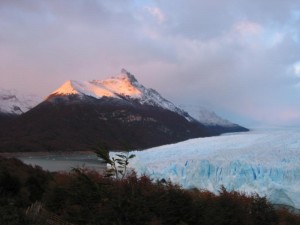
Looking back, I’m not sure that the expedition really needed to be a guided tour. I had assumed that it would be difficult to navigate: a white void with no landmarks and crumbling, treacherous ice. In actuality, there were enormous, distinctive mountains on either side of the glacier, so it was exceptionally easy to orient yourself. There were some crevasses, shafts and fissures in the ice, but they were fairly easily spotted and avoided. Most were ankle-rolling, or at worst, leg-breaking sized, not plunging-to-your-doom, in any case. Before we headed out, the guides had us put on safety harnesses, so that if we did fall down somewhere, it would be easy to attach a rope and haul us back up. The guides were exceptionally paranoid about letting anyone get close to any kind of edge or shaft. The crampons provided such excellent traction that I felt like you’d have to be pretty stupid to fall down any holes. Then again, the guides probably deal with plenty of stupid tourists, so perhaps their caution was justified.
One thing that surprised me was how hard and sharp the ice was. For some reason, I expected that there would be a soft fluffy layer of snow, or at least soft-packed ice on the top. There isn’t. They told us to wear our gloves all the time, not so much because of the cold, but so that if we fell, we wouldn’t cut up our hands on the ice.
Strangely, walking on the glacier reminded me most strongly of hiking on the lava fields in Volcanoes National Park in Hawaii. Except for the fact that one was bright ice, and the other dark rock, they had a lot in common. Both involved walking on a sharp, hard surface that was completely desolate and almost totally devoid of life.
One thing I found really interesting was the degree to which the forms of the ice seemed to mimic land formations: there were ridges and valleys, peaks and and streams. I’m not sure how much of the apparent similarity is simply the result of the human mind imposing a familiar pattern on an unfamiliar landscape, and how much it reveals an underlying similarity. It would be easy for me to believe that the flow of tectonic plates over millions of years and the flow of glacial ice over thousands of years could lead to analogous formations.
The other thing that was really striking was the beautiful, translucent blue color of the ice. It’s a color I had never seen before in nature. Somebody suggested it was a result of minerals dissolved in the water that formed the ice; I hypothesized the color was the result of optical properties (defraction/refraction) of the ice itself. It turns out I was closer to being right, but the real answer has to do with vibrational bond energies and the absorption spectrum of water.
Anyway, photos:
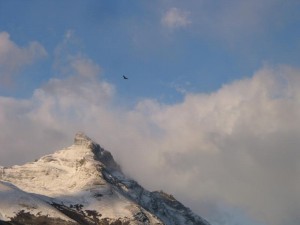
A condor circles high above. These birds were the only animal life we saw near the glacier.
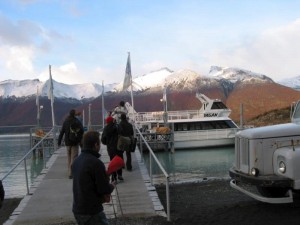
This boat took us across the lake to a small base camp where we gathered gear before starting the hike.
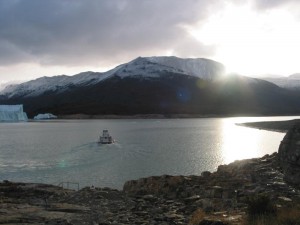
Yeah, lens flare makes anything cooler.

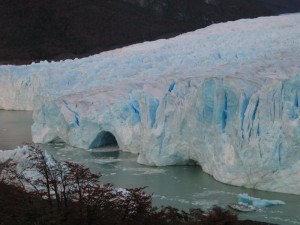
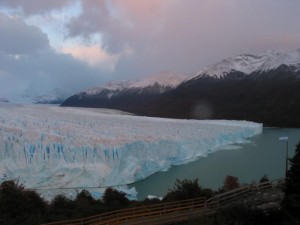
There seems to be something against my stupid American sensibilities when it comes to going to south to hike a glacier in the set of places not contained in Antarctica.
It would probably be easier for me to go south to the Alps, if I wanted to hike a glacier, than to go north to the icy extremities of Sweden or Norway – even if Sweden is only a half-hour train ride from my house.
Also, Brendan, I notice that you demonstrate the unflattering appearance of the harnesses by showing a picture of them on someone other than yourself. Nice move.
The photos were fantastic. I bet they do not due justice to the power and beauty of such a unique environment.
beautiful
Enchanted forests… not just in Europe anymore.
But seriously, that looks like a pretty amazing time.
~Steve